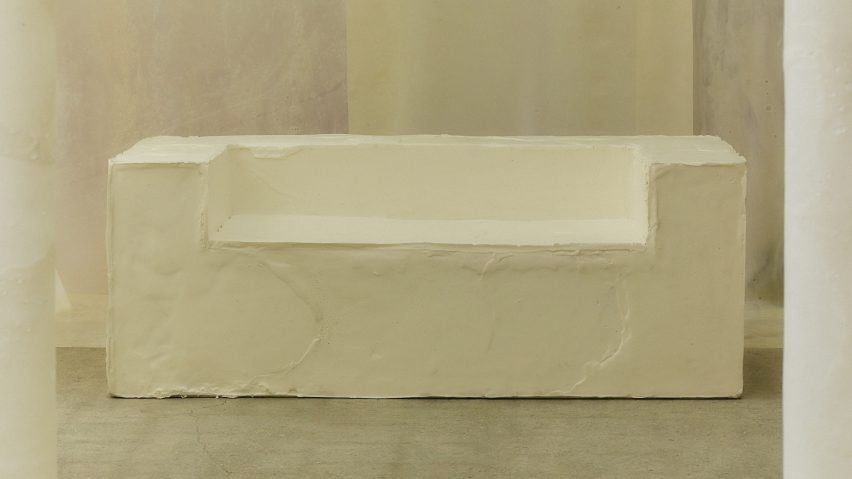As part of 3 Days of Design, Danish practice Natural Material Studio has created a futuristic fossil-free home interior where all the elements, from the curtains to the sofa, are made from the same bioplastic.
White Utopia is Natural Material Studio's most ambitious installation to date, adapting the studio's Procel bioplastic to form massive functioning furniture pieces across three separate rooms – a dining room, a lounge and a bedroom with a walk-in wardrobe.
The exhibition envisions a future where our homes are made entirely using biomaterials like this, which can be endlessly remade into new products and backyard composted at the end of their life, rather than ending up in landfill.
"The installation has for sure been the most challenging to date due to the complexity in scale and the three-dimensionality of the whole 'house'," studio founder Bonnie Hvillum told Dezeen. "You can really start to see how we can live with these new materials."
Natural Material Studio initially developed Procel as a flexible biotextile, used to form everything from clothes to curtains. But recently, the studio started experimenting with adapting its recipe to create whole load-bearing furniture pieces.
The core ingredient is a specific – although nondisclosed – natural protein, which Hvillum says can be derived from either plants or animals.
"It's very much used in the medical industry, also in bookbinding," said the designer, who sources her protein from different suppliers across Europe.
"It's used in many different places," she added. "But when I called them and said 'can you figure out a way of supplying this to me', they were like 'okay, we've never had this question before'."
To create Procel, this natural protein is mixed with a small amount of chalk for strength and a natural softener made from plant oils for flexibility.
Combined in different rations and cast into different moulds, this mixture was used to create not just the textile room dividers found in White Utopia but an entire bio-foam sofa for the living room, stools for the dining area and a giant platform bed that visitors were encouraged to sit on.
By taking out the softener, Natural Material Studio was also able to create more rigid pieces, including a dining table that was originally cast as a simple rectangle but deformed into a more organic shape as it dried.
"The presented design objects are really pushing the possibilities of these materials," Hvillum said. "Opening the door to making them structural is a completely new route for us."
"I think it holds so much potential, creating materials that resemble polystyrene and vacuum-formed plastics."
Furnituremakers including Isomi and Natuzzi have already started experimenting with using natural latex as a substitute for traditional polyurethane upholstery foam, as the plastic is hard to recycle and contains toxic chemicals.
Hvillum argues that Procel could offer another promising alternative, as it can be endlessly recast to form new products or simply buried outside in the garden, where it will degrade within a month.
"We are basically investigating fluidity," Hvillum said. "So everything is in motion and things can move on to have another life. "
"This is how we envision the future to be."
Procel has already made it out into the real world with clients including Calvin Klein and Copenhagen restaurant ÅBEN.
A collaboration with a Spanish luxury fashion house is also in the works, despite the brand being wary of using animal-derived protein.
Hvillum on the other hand argues that animal polymers can actually be more sustainable than their vegan counterpart because they are made from waste residues from the meat industry.
"When we work with animal-based materials, we can actually tap into a waste flow so we work with second-generation materials," she explained. "Whereas when we work with plant materials, we work with virgin materials."
"Sustainability is a lot more complex than just: is it animal or is it vegan," she added. "It's more about: what sources can we reuse from so that we keep things in a circular loop."
The photography is by Peter Vinther.
White Utopia was part of 3 Days of Design, which took place at venues across Copenhagen from 12 to 14 June. See Dezeen Events Guide for more architecture and design events around the world.

